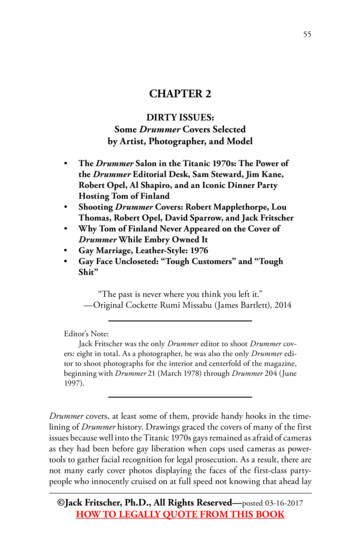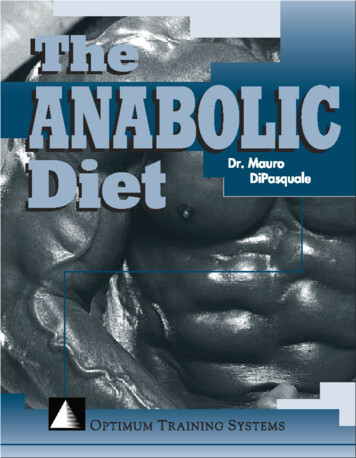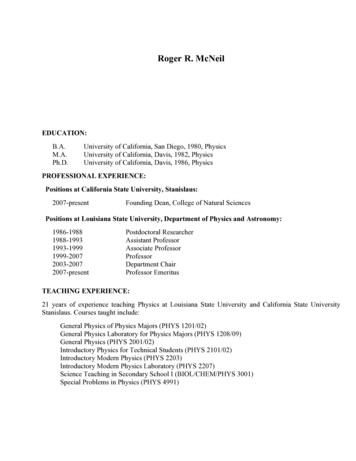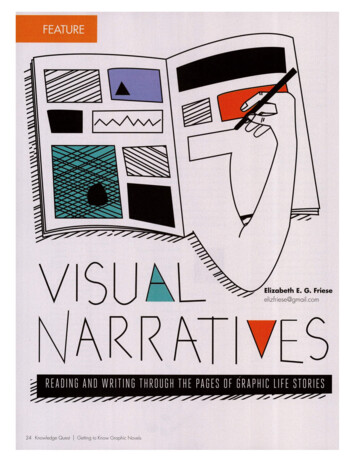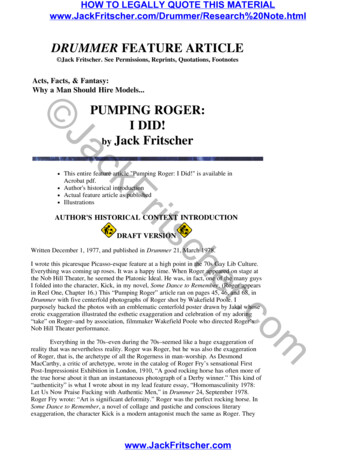
Transcription
HOW TO LEGALLY QUOTE THIS ote.htmlDRUMMER FEATURE ARTICLE Jack Fritscher. See Permissions, Reprints, Quotations, FootnotesActs, Facts, & Fantasy:Why a Man Should Hire Models.ckJa PUMPING ROGER:I DID!by Jack FritscherFrThis entire feature article "Pumping Roger: I Did!" is available inAcrobat pdf.Author's historical introductionActual feature article as publishedIllustrationsitsAUTHOR'S HISTORICAL CONTEXT INTRODUCTIONDRAFT VERSIONchWritten December 1, 1977, and published in Drummer 21, March 1978.om.cerI wrote this picaresque Picasso-esque feature at a high point in the 70s Gay Lib Culture.Everything was coming up roses. It was a happy time. When Roger appeared on stage atthe Nob Hill Theater, he seemed the Platonic Ideal. He was, in fact, one of the many guysI folded into the character, Kick, in my novel, Some Dance to Remember. (Roger appearsin Reel One, Chapter 16.) This “Pumping Roger” article ran on pages 45, 46, and 68, inDrummer with five centerfold photographs of Roger shot by Wakefield Poole. Ipurposely backed the photos with an emblematic centerfold poster drawn by Jakal whoseerotic exaggeration illustrated the esthetic exaggeration and celebration of my adoring“take” on Roger–and by association, filmmaker Wakefield Poole who directed Roger’sNob Hill Theater performance.Everything in the 70s–even during the 70s–seemed like a huge exaggeration ofreality that was nevertheless reality. Roger was Roger, but he was also the exaggerationof Roger, that is, the archetype of all the Rogerness in man-worship. As DesmondMacCarthy, a critic of archetype, wrote in the catalog of Roger Fry’s sensational FirstPost-Impressionist Exhibition in London, 1910, “A good rocking horse has often more ofthe true horse about it than an instantaneous photograph of a Derby winner.” This kind of“authenticity” is what I wrote about in my lead feature essay, “Homomasculinity 1978:Let Us Now Praise Fucking with Authentic Men,” in Drummer 24, September 1978.Roger Fry wrote: “Art is significant deformity.” Roger was the perfect rocking horse. InSome Dance to Remember, a novel of collage and pastiche and conscious literaryexaggeration, the character Kick is a modern antagonist much the same as Roger. Theywww.JackFritscher.com
HOW TO LEGALLY QUOTE THIS ote.htmlboth represent the unachievable lover, the “man that got away” who so tormented JudyGarland.In my intent, Drummer was the first gay magazine to drop gay “prettiness” andhead toward the fresh “de-forming” queer edge where leather breaks the forms of oldways of being and thinking with its progressive metaphor and discipline. This “deforming” has long caused the gaystream to “fear” the leatherstream of queer culture.More a coincidence of the times and not through cause and effect, three weeks after thefirst issue of Drummer was published, Richard Goldstein, the original-recipe “AttackQueer,” wrote a very nasty take on leather culture titled “S&M: The Dark Side of GayLiberation” in The Village Voice, July 7, 1975.Ja I kept that Goldstein column, along with the Harper’s Magazine, July 1975article, “Masculinity: 60 Points of View,” thumb-tacked over my non-electric SmithCorona portable typewriter on which I wrote all my Drummer pieces.ckThe Harper’s piece nails down the intense debate about masculinity in the 70sdedicated to feminism, and thus provided the muscle for my widening Drummer from thespecifics of leather men to the celebration of homomasculine men, a move that laterDrummer publisher, Anthony DeBlase, acknowledged for its greater inclusivity.itsFrGoldstein’s prejudice typified everything in gay culture that opposed thehomomasculine values of the leather lifestyle which Drummer was trying to liberate andpromulgate. Contrarians like him made Drummer a necessity. On CSPAN, in 2002,Richard Goldstein continues spinning his almost ad absurdum debates about the nature ofqueer culture in his opposition to humanists Andrew Sullivan and Camille Paglia. As ananalyst, and as a human, I land on the side of Sullivan-Paglia, but value the leftistdrumbeat of Goldstein marching to his own different Drummer.erchThis civil war, this schism in gay and leather culture, between conservative andprogressive, between femininity and masculinity, between separatism and assimilationleads to what I call “gay vertigo.” People forget that eros has no conscience the way ahard dick has no conscience. The minute, let’s say, you–an artist peddling erotica–start tothink of lesbigay politics and infighting, you fall off your bicycle.om.cMy time line for the pivotal year 1975 is:May 1975 Catacombs opensJune 1975 Drummer first issueJuly 1975 Richard Goldstein anti-S&M essay in Village VoiceJuly 1975 Harper’s Magazine, “Masculinity: 60 Points of View”August 1975 Janus Society foundedIn terms of entertainment, I tried to reflect the hilarity of the time, because we allknew, and said, that nothing so good could last forever.In terms of art, immediately before I became editor in chief invited intoDrummer’s table, I had taught art courses in literature, creative writing, journalism, andfilm for twelve years at university as well as at an art institute. During my twenties inNew York in the 1960s, I pursued personally and professionally the intellect and eros ofboth underground film and experimental theater, and published articles in academicjournals such as Modern Drama, The Bucknell Review, and the Journal of PopularCulture–which were typical of the periodicals where homosexuals published our semicoded and coming uncloseted culture before magazines such as Drummer and TheAdvocate were invented after Stonewall. In pop culture, I saw Andy Warhol glamorizingthe gay sensibility in his art and films in a way that made Warhol a model of gaywww.JackFritscher.com
HOW TO LEGALLY QUOTE THIS ote.htmlcrossover chic.Ja I was influenced as well by the joie de gestalt of my friend whom I met in 1968,the writer and art critic John Richardson, who while living a life in the upper reaches ofthe art world, was a human-scale friend and an upscale icon on the high-leather scene.We had met nine years before I met Robert Mapplethorpe. John Richardson, famously apersonal friend of Picasso, is a writer for Vanity Fair, The New Yorker, and House andGarden, as well as many other magazines, which were and are direct adjuncts of the gaypress. John Richardson is the author of the best-selling trilogy, A Life of Picasso, as wellas of Sacred Monsters, Sacred Masters: Beaton, Capote, Dali, Picasso, Warhol, LucianFreud, Anais Nin (2001). Once, actually, John Richardson and I–just for the fun of it, onone of his visits to my Kalamazoo studio–collaborated in the ’60s–when undergroundfilms were the rage–on a Super-8 film short, Blood of the Black Spider.ckIn this circle, eleven years before Robert Opel was shot in his own Fey Way artgallery in San Francisco, Andy Warhol was shot in his studio by Valerie Solanas, founderof SCUM (Society to Cut Up Men) on June 4, 1968, the day before Bobby Kennedy wasassassinated. My friend and playmate, the art critic Mario Amaya was also shot andwounded by Solanas. As editor of Drummer, I was always acutely aware that a mediaprofile can be as dangerous as buying hustlers off the street; for that reason, I once wrotea Drummer editorial on death, Drummer ####, DATE.itsFrAll this free association does not make one an artist, but it does signify the selfconscious sex-and-art intensity with which we all lived in those “olden days” of the gaypast long before politics became the second intensity, and AIDS became the thirdintensity.I mention Richardson and Picasso and leather and art to connect the helix of whatwas in the air at the time and what talented people I tried to bring to Drummer which wasa blank page open to anything.cherAfter Stonewall–a symbolic event after which the image of queers changed–leather and art clicked. Opportunistically, all S&M leather culture instantly identifiedwith art–from photography to performance–which created the climate for Mapplethorpe’sfine art photographs of leather, as well as the context for thousands of leatherphotographers and artists eager to pronounce their emerging erotica as “art.”om.cSo, in writing, which is art, I intended this very “modern” piece on Rogersomething like the exaggerated paintings by Picasso or Van Gogh or Matisse–not that Ithought I or Drummer was all that–because their paintings were also once consideredboth pornographic and exaggerations. Also they did not cater to the “prettiness” ofconventional art the way Drummer never catered to the “prettiness” of gay culture that sooften–outside Drummer and leather and bear culture–tips dangerously back toward thechicken coop of underage pederasty. In the 1984, I told my colleague John W. Rowberry,who had been Drummer’s office boy and then, later, Drummer editor about his chickendiet video reviews: “You like ’em so young that if sperm could act, you’d give it a goodreview.”Roger was definitely a grown-up, and I was focusing Drummer sexually andesthetically on mature men and–in the best sense–the worship of masculinity, by which Imean the best of masculinity, rather much like “Zen and the Art of MasculineMaintenance.” At the same time, I added the tag line to the masthead of Drummer: “TheAmerican Review of Gay Popular Culture.” My intent was to make Drummer asemphatic esthetically as it was erotically. I went in pursuit of artists who were writers,www.JackFritscher.com
HOW TO LEGALLY QUOTE THIS ote.htmlphotographers, painters, and illustrators. Bringing in their personal visions madeDrummer a personal magazine each issue, and not a corporate vehicle for generatingadvertising revenues. In this context, “Pumping Roger,” seeming to be one thing whilereally much more, shows the shape-shifting character of what I intended leather andhomomasculinity and art to effect in the quintessential Drummer in the cultural war of1970s’ gay liberation.Years passed.Ja In February 1994, I received a phone call from Roger’s manager whoremembered me from this 1978 article and told me how the Roger story ended. MyJournal entry from February 17, 1994, follows this feature. 2002, 2003 Jack FritscherFrckThat telephone call was one of the reasons that this enormous collection ofwriting from Drummer, with some notes, seemed a good thing to do. I see both the dutyand the virtue of living a life in writing, and keeping excellent notes. I used my teenagejournals to write the novel, What They Did to the Kid. I used my daily journals of the 70sto write the novel, Some Dance to Remember. I used my journals and correspondenceand interview tapes to write the nonfiction memoir, Mapplethorpe: Assault with a DeadlyCamera. Sooner or later every story comes full circle, every mystery is revealed,everybody comes to conclusion, even myself, eventually. –Jack Fritscher, April 26, 2002The feature article was written December 1, 1977,and published in Drummer 21, March 1978itsActs, Facts, & Fantasy:Why a Man Should Hire Models.erchPUMPING ROGER:I DID!by Jack FritscherI’ve watched Roger at my gym.om.cNo two ways about it: I love, adore, and worship Roger. I would eat his shorts. Iwould sleep on Roger-printed sheets and pillowcases. I would hang Roger wallpaperinside and outside my house. On my deathbed, I’d settle for one last glimpse of hisCharles-Bronson face and Botticelli body.He works out heavy, stripped to the waist, and barefoot. His grey sweatpantsdarken with triangular wet patches in the front, below his navel, and in the rear at thesmall of his back. A line of white jockstrap holds tight against his smooth skin as thesweatpants slip down from his waist toward his tight butt. He stops to hitch them up. Hetightens the draw string. He wipes his hands dry on his thighs. He ignores the mirror. Hespreads a clean white towel over the vinyl-covered bench. He crosses to the weight rackarranged in a neat row along the wall. He glances quickly into the mirror to gauge thepump of his workout. His hands wipe again down his thighs. He inhales. His chest rises.Each hand turns into an iron fist as he grips a pair of 85 pound weights. He walks back tothe bench. The poundage he totes striates the muscles of his forearms and deltoids. Hewww.JackFritscher.com
HOW TO LEGALLY QUOTE THIS ote.htmllooks neither to the right or left. He sits his ass down at the end of the bench, places aweight on the floor at each ankle, rests his forearms on his thighs, and breathes deep. Histhick shoulders rise. His black hair falls soft across his forehead. He is deep inconcentration.DOLLY, ARNOLD, & ROGER;Ja The gym is at an off-hour. Only four or five guys are working out. From theoffice, a radio plays country-western music. On the office window , in a huge full-colorposter of camp, hick-chic Dolly Parton poses in front of Arnold Schwarzenegger. Herhands rest on her black pant-suited hips. Her blonde wig piles high enough to hide mostof Arnold’s face. Out of her shoulders jut Arnold’s huge arms in full biceps shot. Out ofher hip shoots one of Arnold’s enormous legs. Dolly is laughing. Arnold is smiling. Theyboth know they are jokes.ckOn his towel-covered bench, Roger meditates in heavy concentration. Roger is nojoke, no Parton put-on, no Schwarzenexaggeration. His well-muscled body remainsnatural enough to appeal to those who aren’t into heavyweight bodybuilders, and superenough to turn on men who are. An aura of nobility surrounds him, protects his privacyfrom invasion. I can only look at him from a distance, through mirrors brightly, so as notto disturb his concentration.ROGER: ONCE IS NOT ENOUGHerchitsFrHis head raises. He throws himself an ok-let’s-go look in the mirror. Each handlifts a weight to each thigh. He lays back on the towel-covered bench.
In my intent, Drummer was the first gay magazine to drop gay “prettiness” and head toward the fresh “de-forming” queer edge where leather breaks the forms of old ways of being and thinking with its progressive metaphor and discipline. This “de-forming” has long caused the gaystream to “fear” the leatherstream of queer culture. More a coincidence of the times and not through .
